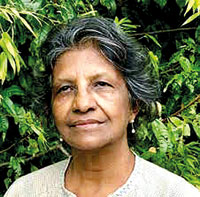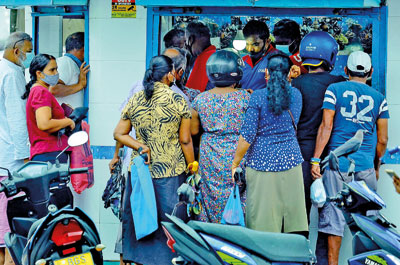News
‘Only the range of groups tested will give a reading whether caseload is dropping or not’

Prof. Kamini Mendis
Sri Lanka which is in lockdown needs to keep a close eye on the situation to check whether the number of infections and deaths is coming down.
This was the call from public health expert Prof. Kamini Mendis who reiterated that such monitoring should be transparent. There should be clarity on how testing is being carried out to assess whether case numbers are reducing because of the lockdown.
To get an accurate reading whether the case-load is coming down, there is a need to know whom we are testing, said this Professor Emeritus of the University of Colombo and Public Health and Malaria Expert formerly of the World Health Organization (WHO).
“If some of these tests are being carried out on COVID-19 positive people after 14 days to check whether they are free of the infection to be released from treatment centres, this testing will not give us a true picture of the degree of spread,” she said, pointing out that then these test results give us no indication of the actual new cases.
Prof. Mendis said: “The range of categories that need to be tested include people in the community; the patients who walk into hospital OPDs; the contacts of people who become positive; and those who are referred for testing with symptoms of COVID-19. To know whether the COVID-19 infections are coming down, we need to know who exactly is being tested.”
Then and only then will Sri Lanka know whether the situation is getting better or worse and on which finding, short-term decisions can be made, she said.
Making use of full
potential of lockdowns
Focusing on the lockdown, Prof. Mendis said that keeping a tight rein on people’s movement for four or five days and then releasing it for a day will not serve the purpose, as people flock to shops to buy their stuff. When people are told that the lockdown would be eased on a certain day to get supplies, it is an invitation, naturally, to rush out of their homes. This is the worst thing for a COVID-19 spread. Ideally, we should have the shops selling provisions, vegetables and fruit and also pharmacies open. One person from one house can be allowed to leave their home and buy what they require. This will not lead to crowding and people who are aware of the dangers of the disease will take precautions.
“As has been proven during the pandemic by the experiences of other countries as well as our own, the transmission of the virus can be effectively controlled through these measures. This is why lockdowns should be used to their fullest potential,” she said.
She explained that with farmers allowed to cultivate their land so that there is no food shortage, like in earlier lockdowns, we should allow the vegetable and fruit lorries to operate and choonpaan trishaws to sell their bakery products. It is just a logistical and organizational issue that the administrators at ground-level in their own areas can handle with efficiency.

Crowds at a fish stall in Kotahena as soon as lockdown restrictions were lifted on Tuesday. Pic by Indika Handuwala
| Vaccinate the vulnerable to prevent severe disease and death – clinicianEvery day, clinicians battle to save the lives of COVID-19 patients with severe disease in the Intensive Care Units (ICUs).The ICUs are full and the wards are also full, said a clinician, declining to be named in view of the Health Ministry sending out instructions muzzling independent voices from the ground-level.He said that they are still getting a lot of patients with bad pneumonia and even after they survive the “acute” phase, they are oxygen-dependent for about three weeks. There is also permanent damage to the lungs and in the long-term, these people would need frequent medical treatment like others with respiratory illnesses such as asthma and chronic obstructive pulmonary disease (COPD).The clinician says that from among those seeking treatment for severe COVID-19, about 5% have lung complications. So it is vital to prevent patients from going into COVID-19 pneumonia. “We are seeing ‘bad’ COVID-19 induced pneumonia in this third wave, which we did not see in the first and second waves. Therefore, it is critical to vaccinate the most vulnerable people who will get severe disease. They are the elderly and those with co-morbidities,” he added. When asked about treatment, this clinician said that a person with mild disease is monitored so that they can respond if that person goes into severe disease. While the monitoring is going on they provide a lot of nutrition, fluids and also Vitamins C and D. However, there is no proven benefit of these vitamins against COVID-19. For those with severe disease, intravenous antibiotics, dexamethasone (a steroid) and blood thinning medications are administered, the doctor said, adding that when necessary they are also given oxygen.
| |
| Testing strategy needs a change– revisions on the table but no actionAn urgent and immediate change in the testing strategy is essential in view of COVID-19 leaving a trail of infections and deaths across the country, the Sunday Timeslearns.A revised strategy is on the table but action is yet to be taken to implement it. The current need is to identify the positive people quickly through Rapid Antigen Testing (RAT) which is speedier and cost-effective for large numbers, rather than RT-PCRs which take a longer time to yield results and are more expensive, it is understood.RAT can detect asymptomatic cases who have high viral loads and as such is effective in breaking the chain of transmission. It costs around Rs. 800 to 1,000 per test kit, sources said.Even though RAT can miss around 20% of cases and RT-PCR tests are more sensitive, not all such RT-PCR positive results indicate an active infection, it is learnt. In addition, the turnaround time for RT-PCR testing is around 2-4 days and the cost is nearly 5-7 times higher than RAT.RT-PCR is not a screening test but a diagnostic tool and in emergency situations as of now, should be used only to confirm when there is a doubt about the RAT result, sources said. They added that the Health Ministry would be able to save a lot of funds while also easing the load on the laboratories if the switch from RAT to RT-PCR is done without delay. |

